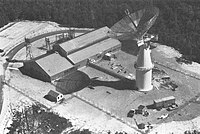Radar telescope

Do you remember playing tag with your friends where you had to find them by looking around? A radar telescope works kind of like that, except instead of playing tag with your eyes, it uses radio waves to look for things in space.
So, imagine you are in a dark room with a flashlight. If you shine the flashlight on a wall, you can see the wall because the light bounces off of it and comes back to your eyes. Radar telescopes work the same way, except they use radio waves instead of light.
These radio waves are sent out from the telescope antenna and travel through space until they hit an object like a planet, a moon, or an asteroid. When the radio waves hit the object, they bounce off and come back to the telescope. The telescope then collects these radio waves and turns them into images and data that scientists can study.
Radar telescopes are really helpful for studying objects in space because they can see through things like clouds and dust that optical telescopes can't. They can also give us very detailed information about the size, shape, and composition of objects in our solar system.
So, just like how you use your flashlight to find your friends in a game of tag, scientists use radar telescopes to explore the universe and find amazing things that we might not have been able to see otherwise.
So, imagine you are in a dark room with a flashlight. If you shine the flashlight on a wall, you can see the wall because the light bounces off of it and comes back to your eyes. Radar telescopes work the same way, except they use radio waves instead of light.
These radio waves are sent out from the telescope antenna and travel through space until they hit an object like a planet, a moon, or an asteroid. When the radio waves hit the object, they bounce off and come back to the telescope. The telescope then collects these radio waves and turns them into images and data that scientists can study.
Radar telescopes are really helpful for studying objects in space because they can see through things like clouds and dust that optical telescopes can't. They can also give us very detailed information about the size, shape, and composition of objects in our solar system.
So, just like how you use your flashlight to find your friends in a game of tag, scientists use radar telescopes to explore the universe and find amazing things that we might not have been able to see otherwise.
Related topics others have asked about:
